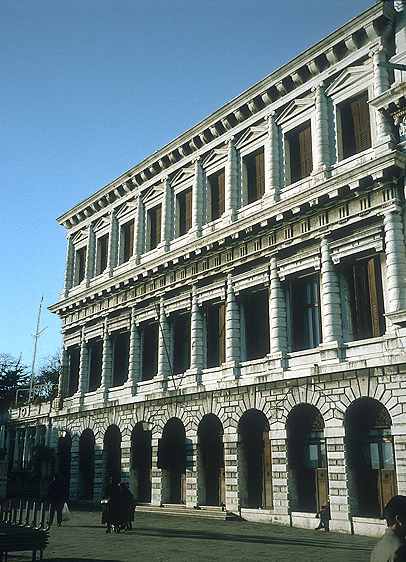La Zecca
Venice, begun 1536
Architect: Jacopo Sansovino
BACKGROUND
Commission
After a competition in 1535, Jacopo Sansovino was commissioned to design La Zecca, which means "the Mint," by the Venetian Republic in 1536. The building functioned as a place to mint and store the Republic's gold.
Location
The Zecca is located along the waterfront in Venice next to to the Library of San Marco. Before its construction, the area was occupied by a conglomeration of structures such as cheese and salami shops.
Adding a Third Story
The building was originally two stories high, which accounts for the large, overhanging cornice at the top of the second story. The third story was added in the late 1550s to increase the amount of usable space and prevent overheating from the combined heat of the furnaces on the ground story and the sun on the second-story roof.
The identity of the architect of the third story has not been established by recent scholarship, but the direct involvement of Sansovino in this addition is now doubted.
FEATURES IN COMMON WITH PALAZZO CAPRINI
Bramante's Influence
The influence the façade of Bramante's Palazzo Caprini, which was later destroyed, is suggested by several similar features.
Two-Story Height
Although La Zecca is now three stories high, it originally resembled the Palazzo Caprini in being two stories high.
Rusticated Arcade on the Ground Story
The ground stories of both buildings were designed as rusticated arcades containing shops. Before the site for the Zecca was cleared, an agreement had been made to provide street-side stalls for the cheese shops and other vendors who were displaced.
Doric Order Applied to the Piano Nobile
The Zecca resembles the design of the Palazzo Caprini in having a piano nobile that is articulated by Doric order engaged columns carrying entablatures.
Lack of Sculptural Decoration
Like the Palazzo Caprini, the Zecca has no sculptural ornamentation.
Uniformity of Bays
The Zecca resembles the Palazzo Caprini in not accentuating the central doorway or the corners so that all the bays of the façade are alike except for minor differences within Bramante's ground-story arches.
MANNERIST FEATURES
Odd Appearance
The conspicuously odd appearance of the Zecca is a result of several Mannerist features.
Accentuating Window Lintels
The Zecca's second-story windows are capped by two lintels instead of one, and they both project outward on corbels to the same plane as the columns. This arrangement makes the lintels look like canopies and makes the columns look hemmed in like the recessed columns Michelangelo designed for the Laurentian Library.
Crowding of Features
The lintels of the piano nobile seem to crowd the columns on each side, recalling Michelangelo's close spacing between the pediments and columns in the vestibule of the Laurentian Library of San Lorenzo in Florence.
Although probably not part of Sansovino's work, the pediments of the third-story windows also seem compressed between the cornice and the window frame.
Using Banded Rustication
Sansovino used a form of rustication in which blocks are inserted into the piers and column shafts at regular intervals.
●Ground-story piers. Alternate courses of the ground-story piers are formed by pier-wide stones.
●Second-story columns. The column shafts of the second story are banded by the alternation of large and small drums.
●Third-story columns. The appearance of bands formed by the large drums is continued around the sides of the window frames on the third story. This variation had been illustrated in Serlio's Treatise in 1540.
Expressive Character of Rustication
The vigorous and plentiful use of rustication on the Zecca, which is not typical of Sansovino's general style, expresses the building's function as a storehouse of the treasury.
The coarse, heavy treatment of the stone advertises the strength of a fortress to potential thieves.
The minting process, in which pieces of gold are stamped into coins, is suggested by the impression of compression created by the heavy stacks of blocks.
INFLUENCE OF LA ZECCA'S RUSTICATION
Architects Who Used Banded Rustication
According to Vasari, Sansovino was the first architect in Venice to use rustication. Several important younger architects were influenced by its rustication.
Serlio
Serlio, who had been in Venice from 1527 to 1541, published illustrations of banded rustication in 1540. His publications contributed to the popularization of this form in northern Europe.
Ammannati
Ammannati, who worked for Sansovino when the Zecca was under construction, used banded rustication for the courtyard addition to the Palazzo Pitti in Florence in the 1550s.
See visual summary by clicking the Views button below.




 Add Placemark
Add Placemark Go Back
Go Back 




